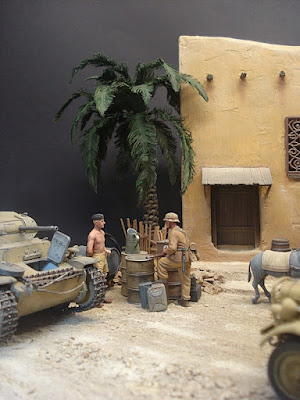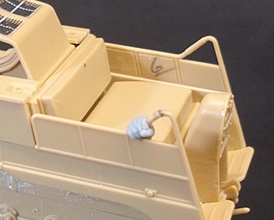Buenas,
The Best of Both Worlds
The Early 1930s were a time of increasing military development in Germany as the country rearmed, first clandestinely and then in the open. half-track vehicles were among those developed for the German forces, and were seen as an important type, given that they could potentially combine the advantages of both wheeled and tracked vehicles. The armed forces were particularly interested in the development of a smaller, airliftable half-track option that could be attached to alpine and airborne units operating in difficult mountainous conditions, to haul guns and provisions.
Renowned domestic motorcycle manufacturer NSU Motorenwerke was tasked with designing this compact half-track, and responded with a motorcycle style layout with a single front wheel, a design based upon a patent acquired in June 1039 and which they were originally intended for use in the forestry industry. A number of prototypes were made in 1940, undergoing military testing and eventually making it to a limited production run from Summer 1940 known as the 0 Series, with a number of practical adjustments having been made in the meantime. It was officially adopted in June 1941 as Sd.Kfz.2, and often referred to as "Kettenkrad".
O Melhor de Dois Mundos
O início da década de 1930 foi um período de crescente desenvolvimento militar na Alemanha, á medida que o país se rearmava, primeiro clandestinamente e depois abertamente. Os veículos de meia-lagarta estavam entre os desenvolvidos para as forças alemãs e eram vistos com um tipo importante, visto que poderiam combinar as vantagens dos veículos de rodas e de esteiras. As forças armadas estavam estavam particularmente interessadas no desenvolvimento de uma opção de meia-lagarta menor e transportável por via aérea, que pudesse ser utilizada a unidades alpinas e aerotransportadas que operassem em terrenos montanhosos difíceis, para transportar armas e provisões.
A renomada fabricante nacional de motocicletas NSU Motorenwerke foi encarregada de projetar este veículo compacto de meia-lagarta e respondeu com um arranjo estilo motocicleta com uma única roda dianteira, um projeto baseado em uma patente obtida em junho de 1939 e que originalmente se destinava ao uso na indústria florestal. Vários protótipos foram fabricados em 1940, passando por testes militares e, eventualmente, entrando em produção limitada a partir do verão de 1940, conhecida como Série 0, com uma série de ajustes práticos sendo feitos nesse meio tempo. Foi oficialmente dotado em junho de 1941 como Sd.Kf.2, e frequentemente chamado de "Kettenkrad".
The Kettenkraftrad Design
The Kettenkraftrad was comprised of a motorcycle-esque front section trailed by a tracked bathtub chassis, with fuel tanks either side of the driver and a 36hp 1,478cc liquid-cooled 4-cylinder engine further behind in the center of the vehicle, all squeezed into a space only a meter wide. If required it could even run without the front wheel attached, and at the rear, there was seating for two passengers in addition to a join which could be used to attach a dedicated trailer. Interleaved wheels were employed in the torsion bar suspension, helping to ensure excellent footwork, even on rough terrain. Much like larger counterparts, the tracks were fitted with needle bearings, while a special linkage applied a brake to one of the tracks when the driver turned the front wheel past 15 degrees, to assist with smooth steering.
O Projeto Kettenkraftrad
O Kettenkraftrad era composto por uma seção dianteira semelhante à de uma motocicleta, seguida por um chassis tipo banheira sobre esteiras, com tanques de combustível de cada lado do motorista e um motor de 4 cilindros refrigerado a líquido de 1.478 cc e 36 cv mais atrás, no centro do veículo, tudo espremido em um espaço com apenas um metro de largura. Se necessário, podia até mesmo rodar sem a roda dianteira acoplada e, na traseira, havia assentos para dois passageiros, além do engate que podia ser usado para acoplar um reboque dedicado. Rodas intercaladas foram empregadas na suspensão com barras de torção, ajudando a garantir excelente mobilidade, mesmo em terrenos acidentados. Assim como em modelos maiores as esteiras eram equipadas com rolamentos de agulhas, enquanto uma articulação especial acionava um freio em uma das esteiras quando o motorista girava a roda dianteira mais de 15 graus, para auxiliar na direção suave.
Evolution of the Kettenkraftrad
Production in the earnest began in 1941, with 420 vehicles produced that year and reaching units the next year. numbers are approximate, but thereafter around 1,000 were produced in 1942, 2,500 in1943 and 4,500 in 1944; vehicles manufactured in 1943 and 1944 can be identified by features such as the rounded taillight base design, cast metal front hook and sheet metal armrests at the rear.Thereafter, headlights were removed and the Kettenkraftrad design rather simplified for ease of production.
Evolução do Kettenkraftrad
A produção propriamente dita começou em 1941, com 420 veículos produzidos naquele ano e atingindo a marca de 1.000 unidades no ano seguinte. os números são aproximados, mas depois disso foram produzidos cerca de 1.000 em 1942, 2.500 em 1943 e 4.500 em 1944; os veículos fabricados em 1943 e 1944 podem ser identificados por características como o design arredondado da base da lanterna traseira, o gancho dianteiro de metal fundido e os apoios de braço de chapa metálica na traseira. Posteriormente, os faróis foram removidos e o design do Kettenkraftrad foi simplificado para facilitar a produção.
The Kettenkraftrad in Service
Although originally intended for a rather narrow scope of deployment with alpine and airborne units, the Kettenkraftrad was also well-adapted to use in the desert conditions of North Africa and the mud of the Russian interior, which meant that it in fact experienced assignment to a much more widespread range of units covering all fronts of WW II. Some of the duties entrusted to the Kettenkraftrad included the laying of communications cables, patrol missions, and transmission of orders; it was even requested by the Luftwaffe for transport of ordnance and fuel, as well as towing aircraft. The Kettenkraftrad was indeed a vital cog in the German military machine.
O Kettenkraftrad em Serviço
Embora originalmente concebido para um escopo de implantação bastante restrito com unidades alpinas e aerotransportadas, o Kettenkraftrad também foi bem adaptado para uso nas condições desérticas do Norte da África e na lama do interior da Rússia, o que significou que, de fato, foi designado para uma gama muito mais ampla de unidades, cobrindo todas as frentes da Segunda Guerra Mundial. Algumas das tarefas confiadas ao Kettenkraftrad incluíam a instalação de cabos de comunicação, missões de patrulha e transmissão de ordens; foi até mesmo requisitado pela Luftwaffe para transporte de munições e combustível, bem como reboque de aeronaves. O Kettenkraftrad era de fato uma peça vital na máquina militar alemã.
Sd.Kfz.2 Kettenkraftrad Specifications
Lenght (comprimento): 3m
Width (largura): 1m
Height (altura): 1,2m
Weight (peso): 1,56t
Crew (tripulação): 3
Engine (motor): 1.478cc inline-4 gasoline engine
Maximum Output (potência máxima): 36hp
Maximum Speed (velocidade máxima): 70km/h
Maximum Range (alcance máximo): 250km
Maximum Load (peso de carga máximo): 325kg
Maximum Towed Load (peso máximo rebocado): 450kg
Pintura e weathering inferior.
Pintura das figuras.
Como a aparência da cabeça do piloto não ficou lá estas maravilhas, providenciamos uma substituta. Talvez fique melhor.
Voltando à montagem e pintura da moto. Conjunto de tração no lugar.
E, as 3 figuras já bem encaminhadas.
Seguindo com o trabalho de detalhamento com decais e pintura.
Montagem do conjunto motor/posto do motorista dentro do chassis.
Montagem do conjunto Garfo Dianteiro no chassis e ajuste das mãos do motorista com o Guidão.
Antes de finalizar os detalhes de pintura e acabamentos (cabos e controles), precisamos testar o encaixe das outras duas figuras.
Até mais!



























































































